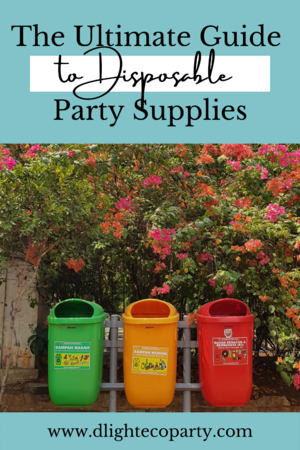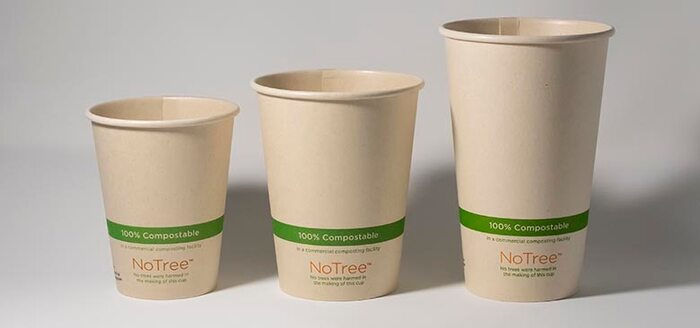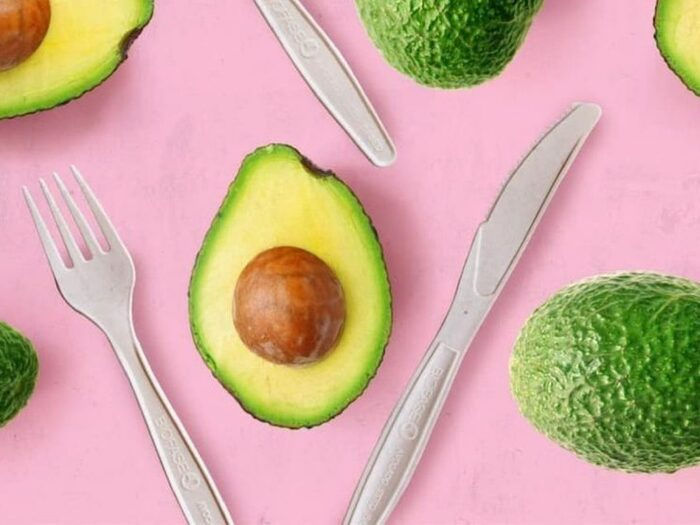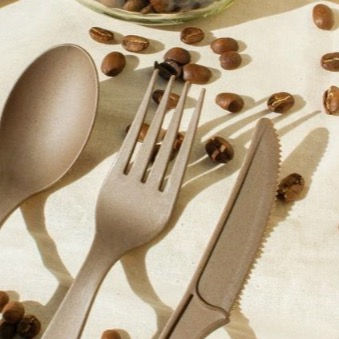The Ultimate Guide to Disposable Party Supplies
- Sari Sime
- Sep 1, 2021
- 8 min read
Updated: Nov 14, 2021

When I first started researching disposable items that are eco-friendly, I thought it was enough to see "eco-friendly", "green", "compostable" and "biodegradable" on the products. Very fast I learned there is a lot of misleading information and greenwashing when purchasing disposable party products. So, I decided to write down all the alternative materials used for plastic, from cutlery to plates, to cups, and from there to napkins. Let's dive in!
You can already guess that plastic will always be the most harmful unless you are reusing it for years, so I'm going to more concentrate on introducing "eco-friendly" alternative materials for plastic. We have to understand the difference between all disposing options so that we can understand what products are most eco-friendly.
1. Trash This is the worst option and we want to avoid this at all costs. When you throw anything into the trash it will end up in the landfill and the decomposing of the product is much longer.
2. Recycling When we recycle products they will be sorted out and repurposed into new products. This is a good moment to mention, that most of the recyclables is not actually recycled. I truly recommend diving into this topic if you have time. United States Environmental Protecting Agency is writing following: "The total generation of municipal solid waste (MSW) in 2018 was 292.4 million tons (U.S. short tons, unless specified) or 4.9 pounds per person per day. Of the MSW generated, approximately 69 million tons were recycled and 25 million tons were composted. Together, almost 94 million tons of MSW were recycled and composted, equivalent to a 32.1 percent recycling and composting rate." That means over half of all the recyclables is not recycled!
3. Composting Shortly, composting means breaking down organic waste into soil to help plants grow. This is basically a process that does not leave any trash behind, and therefore implementing composting into our lives in my opinion is crucial because of the issues we are facing with trash. a) Industrial Composting Most of the "compostable" products we see in the market now require industrial composting. In the United States, there are not many industrial composting facilities. These facilities can handle larger amounts of compostables and also bio-plastics that home composting cannot do.
b) Home composting
At-home composting is composting in your backyard or using a composting bin at home or a local independent composting facility. This is what I do with my business, I collect compostables after the party and take them to a local composting facility and they do the composting on my behalf.
PARTY CUPS

These are the alternative materials that I found for party cups. Shortly, there is no party cup that is recyclable or compostable at home. Plant-based / PLA plastic cups / Corn starch Also called "biodegradable party cups", "compostable party cups". Like we learned above, even though, you see "compostable" on a product it might not be compostable in your local composting facility and requires industrial composting. Unfortunately, many time PLA plastic is something many independent composting facilities don't approve. When we compare these cups to regular plastic, it seems that these cups are less toxic for the environment and producing these cups emits fewer greenhouse gases and requires less energy, which, in my opinion, makes this cup a better option.
Paper cups Many don't know that paper cups are covered with polyethylene linear so that they can hold liquids. Because paper cups have this plastic linear, they cannot be recycled. In the United States, there are few recycling facilities that accept paper cups as recyclables, check your local recycling center before purchasing these cups. If you dispose of paper cups incorrectly they can stay in the landfill for 20 years. Paper cups are also not compostable because of the plastic linear.
PLA / plant based / corn starch linear
I did also find paper cups that are covered with "corn starch based material", which means they have used PLA plastic to cover the cups. Seems like these cups are compostable, but you want to check this with your local composting facility first.
No Tree Cups made of Sugarcane Sugarcane cups are definitely the environmentally friendlier solution when choosing disposable cups. It doesn't require trees to be cut down and also it is compostable at home. I would just double check this with the composting facility before you decide to do that. Sugarcane cups still has a thin PLA plastic linear, but like above it is accepted in some composting facilities.
DISPOSABLE PLATES
Some of the disposable plates can be composted at home! But be mindful with the food your serve, grease is not a friend of composting.
Paper Almost all the cute paper plates in the local party story include plastic. So just like cups, the paper plates are covered with plastic linear meaning it is not recyclable and when it ends up in the landfill it will take up to 20 years to decompose. There is paper plates that come with PLA plastic linear, those usually are the ones that are white or brown.
Palm Leaf This is so far one of the two disposable products I have approved and feel comfortable using. They are compostable and toxic-free BUT they need to be composted in order to serve their purpose. They do break down faster than any other disposable material but I don't want to promote trashing this item. The other reason why I like these plates a lot is the fact that they are made of naturally fallen leaves.

Bamboo Bamboo plates are similar to Palm Leaf Plates but in my understanding, they do require a bit more factorial work when produced making them less environmentally friendly than palm leaf plates are. However, this is a good option if you are looking for compostable disposable plates. Please, instead of throwing them into the trash find a local composting facility to dispose of them correctly.
Sugarcane and Bagasse You have probably seen "Sugarcane" or "Bagasse" plates in the market. Shortly, these plates are by-products of the sugarcane industry. Unlike cups made of sugarcane, these plates will not have the plastic linear and therefore they are compostable.
CUTLERY
Great news, some of the cutleries can be composted at home!
PLA plastic and bio plastic utensils Bioplastics (plant based palstics) are plastic thet is sourced from renewable biomass resources like vegetable fats and oils, corn starch, straw, woodchips, sawdust, recycled food waste. Which is different to traditional plastic which is requires natural gas and oil to be made. Most known bioplastics produced now are PHA and PLA, so far I have seen PLA mentioned in many cutleries and that's why in my previous posts you don't see me talking about PHA that much.
I'm personally a little sceptical about bioplastics and avoid using them as much as I can. I do think it is a better option over regular plastic.
Bioplastics are usually claimed industrially compostable and they require less energy in manufacturing, but it might not be the best solution because
1) bioplastics are not recyclable and are many times mixed as such ruining the whole patch at the recycling facility,
2) it requires industrial composting which the US doesn't really offer,
3) switching up from plastic to bioplastics could lead us to overwhelm the farming industry = we would need a lot more material to produce bioplastics to meet the demand,
4) when bioplastics end up in landfills it can stilltake over 10 years to decompose.
Here are few exciting cutlery innovations I think will be a good shot when choosing cutlery for your party:
Avocado Avocado cutlery is made of avocado pits that have been collected from companies producing guacamole and avocado oil. This item is like bio plastic but instead of wheat or corn, they use avocado seeds.
On the website they claim: "BIOFASE's products are composed of 60% avocado seed biopolymers and 40% synthetic organics compounds, which help our product's excellent mechanical and physical properties." and "Unlike other products that have to be transferred to industrial composting and exposed to high temperatures for biodegradation, BIOFASE’s biodegradable products can biodegrade on land or in any landfill.".
The company also claims that manufacturing these utensils is a lot less harmful than other bio plastics.
Avocado Cutlery is a lot better option than plastic cutlery is, especially if you are going to order big quantities like for weddings, restaurants and big events.


Coffee Ground Utensils
This is the newest innovation for disposable utensils and very exciting one. The cutlery is made with leftover coffee grounds combined with home compostable materials. Meaning, this cutlery does not include plastic or even bio plastics! It is at home compostable.
Birchwood Cutlery Nicknames; Bamboo Cutlery, Wooden Cutlery..
This is the material I have chosen to use when I have to go with disposable utensils. It will compost in composting bin and it is toxic-free and sturdy. Also, I think from all options this is the cutest ;). The only downside is that this cutlery requires trees to be cut down unlike avocado cutlery or coffee ground cutlery, but usually, it is leftovers from the birchwood industry.
NAPKINS
With napkins, it is a bit harder to find eco-friendly options and that's why I always rather just use reusable napkins than paper napkins. With reusable napkins, I recommend spending some time finding the best fabric because the fabric industry can also be not very eco-friendly. So far I have been using organic flannel napkins, I would recommend these or linen napkins.
Paper Paper napkins are very wasteful party product since unfortunately, it is not recyclable and often times not even compostable. You can compost some paper napkins if the napkin has not been used to wipe toxic products or if it's not too greasy (grease residue can reduce oxygen in the compost while cleaning products are harmful to microorganisms). When paper napkins end up in landfills it takes months to decompose. Paper napkins from recycled paper If you must go with paper napkins please choose napkins made of recycled paper instead of virgin paper. This means the napkins will be brown without special designs, which I know, is not very creative. Recycled paper napkins are made of paper that was already recycled. This is better because regular paper napkins require cutting down trees when recycled paper napkins are using the paper that was already made. Tree-Free Napkins After posting this blog I did more research about napkins since I am going to launch an eco-friendly disposable party package and I found out there are tree-free napkins in the market. This is great! Tree-free napkins are made of bamboo and sugarcane which doesn't require cutting down trees, therefore I think it is a much better option than paper napkins. Please note, that if you use this napkin to clean toxins (eg. cleaning products) or you serve very greasy food, the napkins are not compostable.
Finding the right products for you can be a lot of work and overwhelming, but if you do your research once you will not have to do it again unless you move to another city/state.
Here is my checklist of where and what to check before you purchase anything:
1. Check if you have an INDUSTRIAL / COMMERCIAL composting facility near you
- IF YES: You can purchase PLA plastic cups, plates, and cutlery
-IF NO: Avoid PLA at all cost. Remember, most of the paper disposables will have PLA linear, so avoid those too. Choose either sugarcane, bamboo, or palm leaf disposables.
2. Check if your area has a private composting facility and ask what items they approve.
Please don't assume you can just drop off anything at a local composting facility. Give them a call and ask for a consultation before you purchase anything.
3. Reuse If all this seems way too overwhelming to you, then I would recommend skipping all the disposables and concentrate on using real plates and cups. Reusing plates is the best option anyways above any disposable products. Check a local catering or a party rental company, they will be happy to help you with rentals if you do not want to buy your own storage!







Yorumlar